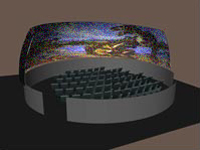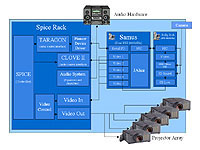| |
The
Earth Theater:
The Earth Theater at the Carnegie Museum of Natural History
is a Panoromic SkyVision Theater, a product of SkySkan, Inc.
The theater has a 40 foot diameter, a 210 degree horizontal
viewing angle, a 30 degree vertical viewing angle, and seats
an audience of 68. The theater's five digital light projectors,
slide projectors, lighting instuments, and 4.1 channel surround
sound are driven by SkySkan's Spice Multimedia Control System. The SkyVision system was specifically designed for the playback of pre-rendered full-dome & panoromic digital video. |
 |
|

ETC System Diagram
Click to view |
ETC Panoromic Real-time Interaction System:
The Entertainment Technology Center's system consists
of two off-the-shelf 866Mhz Intel Pentium III Computers:
one for serial communication with Spice and rendering
graphics to all five projectors, and a second for sound
playback and interactive inputs. The rendering computer
employs five ATI Radeon
video cards on the PCI bus. The sound/interaction computer
uses a Creative
Labs Sound Blaster Live! card in order to create three-dimensional
spatialized audio. Audience interaction is done through
an active infra-red camera, coupled with an ImageNation
PXC200 frame grabber, and an omni-directional microphone
plugged into the SoundBlaster card.
The main software used on the project is Alice,
a 3D authoring environment developed by the Stage3
Research Group at Carnegie Mellon University. Alice
is designed for the rapid prototyping and development
of interactive 3D graphics. Alice was intended to be
used for material created for desktop computer and Head-Mounted
display use. The ETC Team and Stage3 collaborated to
adapt Alice for playback across multiple displays by
having each camera object in the virtual environment
output to a separate video card.
In order to create a seamless view across the five
projected images, the ETC Team employed an alpha-channel
gradient within the virtual world. This created issues
where one camera could see another camera's blending
object, so the visibility of the blending object was
tied to the refresh rate of the projectors.
Since such an immense computational load was placed
on a single computer, audio playback and processing
of audio and video interations were outsourced to a
separate machine. The remote sound and vision server
programs were written by the students on the project.
|
|
|
|
|
